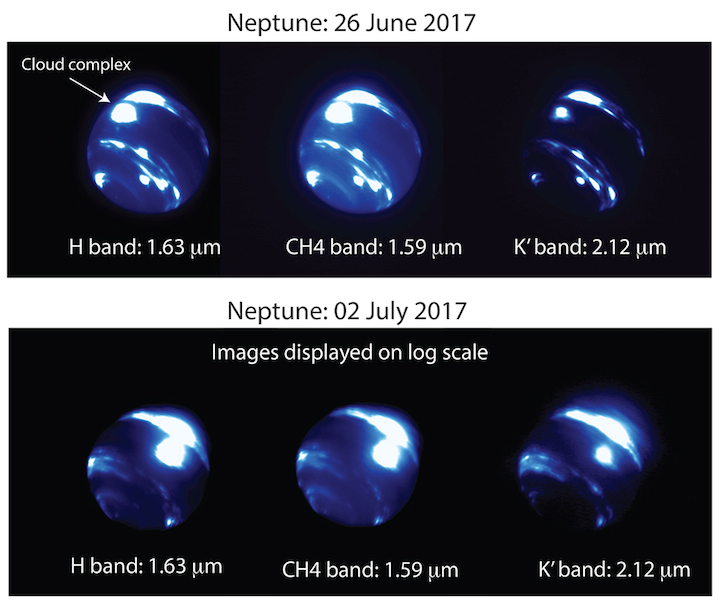8.08.2017

While observing Neptune at dawn with the Keck Telescope, grad student Ned Molter discovered an unusually bright, nearly circular storm system near Neptune’s equator, a region where astronomers have never seen a bright cloud. The center of the storm complex is ~9,000 km across, about 3/4 the size of Earth, or 1/3 of Neptune’s radius. (N. Molter/I. De Pater, UC Berkeley/C. Alvarez, W. M. Keck Observatory)
Spectacular sunsets and sunrises are enough to dazzle most of us, but to astronomers, dusk and dawn are a waste of good observing time. They want a truly dark sky.
Not Ned Molter, a UC Berkeley astronomy graduate student. He set out to show that some bright objects can be studied just as well during twilight, when other astronomers are twiddling their thumbs, and quickly discovered a new feature on Neptune: A storm system nearly the size of Earth.
“Seeing a storm this bright at such a low latitude is extremely surprising,” said Molter, who spotted the storm complex near Neptune’s equator during a dawn test run of twilight observing at W. M. Keck Observatory on Maunakea, Hawaii. “Normally, this area is really quiet and we only see bright clouds in the mid-latitude bands, so to have such an enormous cloud sitting right at the equator is spectacular.”
This massive storm system, which was found in a region where no bright cloud has ever been seen before, is about 9,000 kilometers in length, or one-third the size of Neptune’s radius, spanning at least 30 degrees in both latitude and longitude. Molter observed it getting much brighter between June 26 and July 2.
“Historically, very bright clouds have occasionally been seen on Neptune, but usually at latitudes closer to the poles, around 15 to 60 degrees north or south,” said Imke de Pater, a UC Berkeley professor of astronomy and Molter’s adviser. “Never before has a cloud been seen at or so close to the equator, nor has one ever been this bright.”
The discovery of Neptune’s mysterious equatorial cloud complex was made possible by the new Keck Visiting Scholars Program, launched this summer, which gives graduate students and post-doctoral researchers experience working at the telescope, while contributing to Keck Observatory and its scientific community.

Images of Neptune taken during twilight observing revealed an extremely large bright storm system near Neptune’s equator (labeled ‘cloud complex’ in the upper figure), a region where astronomers have never seen a bright cloud. The center of the storm complex is ~9,000 km across, about 3/4 the size of Earth, or 1/3 of Neptune’s radius. The storm brightened considerably between June 26 and July 2, as noted in the logarithmic scale of the images taken on July 2. (N. Molter/I. De Pater, UC Berkeley/C. Alvarez, W. M. Keck Observatory)
“This result by Imke and her first-year graduate student, Ned, is a perfect example of what we’re trying to accomplish with the Keck Visiting Scholars Program,” said Anne Kinney, chief scientist at Keck Observatory. “Ned is our first visiting scholar, and his incredible work is a testament to the value of this program. It’s just been an outrageous success.”
Molter is one of eight scholars accepted into the program this year. His assignment during his six-week stay at the Observatory was to develop a more efficient method for twilight observing, making use of time that otherwise might not be used. Most observers in the Keck Observatory community peer deep into the night sky and cannot observe their targets during twilight.
“Ned had never observed before, and he’s very bright, so when Anne told me about the program, I knew he would be the perfect student for it,” said de Pater. “Now that we’ve discovered this interesting cloud complex in Neptune, Ned has a running start on a nice paper for his Ph.D. thesis.”
Quelle: UC Berkeley/Keck Observatory
